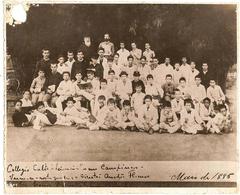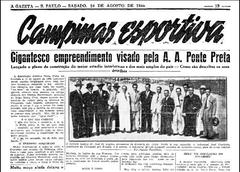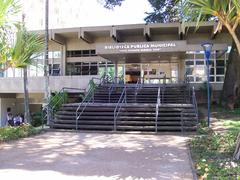Parque Ecológico de Campinas: Visiting Hours, Tickets, and Attractions Guide
Date: 03/07/2025
Introduction
Parque Ecológico de Campinas (officially Parque Ecológico Monsenhor Emílio José Salim) is a landmark urban park in Campinas, São Paulo, celebrated for its blend of historical, ecological, and recreational value. Encompassing approximately 110 hectares, this site invites visitors to explore preserved 19th-century coffee plantation architecture, restored native ecosystems, and vibrant community spaces. Once part of the historic Fazenda Mato Dentro estate—symbolic of Campinas’s agricultural and social history—the park has evolved into a dynamic public space balancing conservation, cultural memory, and leisure (campinas.com.br; Santos, 2002).
Roberto Burle Marx’s visionary landscape design integrates native flora with historical structures such as the Casarão manor, granary, and chapel. The park not only supports biodiversity but also promotes social reconciliation and education, notably through upcoming projects like the Museu da Paz and the Afro-Brazilian cultural center, highlighting the region’s Afro-Brazilian heritage (agenciasn.com.br; correio.rac.com.br).
Open daily from 6:00 AM to 6:00 PM with free admission, Parque Ecológico de Campinas is accessible to all and features paved paths, sports facilities, playgrounds, and picnic areas (campinas.com.br). Whether you’re a nature lover, history enthusiast, or a family seeking green space, the park is a model of sustainable urban development and cultural celebration (Cidade e Cultura; Gazeta SP).
Historical and Cultural Significance
From Coffee Plantation to Public Park
The park’s origins trace back to Fazenda Mato Dentro, a prominent 19th-century coffee estate. Its architectural ensemble—main house (casarão), granary (tulha), and chapel—reflects the wealth and social dynamics of the coffee era (campinas.com.br). The transition from rural estate to public park was formalized by Decree No. 27.071 in 1987, marking a broader movement to reclaim historical spaces for conservation and public benefit (Decreto nº 27.071, 1987; Macedo & Sakata, 2003).
Heritage Status and Restoration
The park’s built and natural environments are protected at state and municipal levels (Correio Popular, 1989). Restoration efforts, including those guided by the Plano Municipal do Verde, have revitalized the manor, granary, and chapel, and reforested extensive areas with native species (Prefeitura de Campinas, 2015; Fregonesi, 2009).
Addressing Afro-Brazilian Heritage
A vital aspect of the park’s contemporary cultural mission is transforming historical sites of exclusion into spaces for remembrance and inclusion. The future Museu da Paz and the Center for Afro-Brazilian Memory aim to foster dialogue, education, and reconciliation (correio.rac.com.br; agenciasn.com.br).
Ecological Importance
Biodiversity and Restoration
The park is a major ecological asset within Campinas, supporting remnants of the Atlantic Forest and Cerrado biomes (ICLEI, 2020). Its landscape, conceived by Burle Marx, features native flora from the Piracicaba River basin, as well as select ornamental species (Campinas.com.br; Gazeta SP). Restoration projects have reforested millions of square meters, providing critical habitat for birds, small mammals, and insects (Triplyzer).
Ecosystem Services
Parque Ecológico de Campinas delivers essential services: climate regulation, water management, air purification, soil stabilization, and support for pollination and biodiversity. The park also functions as a green corridor, enhancing connectivity within Campinas’ fragmented urban landscape (ICLEI, 2020).
Environmental Education
The Museu Histórico Ambiental and thematic gardens promote environmental education, linking ecological restoration to local history and social themes (Campinas Virtual). The park’s programming includes workshops, school visits, and guided tours.
Visitor Guide
Visiting Hours and Admission
- Opening Hours: Daily, 6:00 AM to 6:00 PM (campinas.com.br).
- Admission: Free for all visitors. No ticket is required.
Getting There & Accessibility
- Location: Slightly outside Campinas city center, well-connected by car, taxi, and public transportation. Ample on-site parking available.
- Accessibility: The park features paved, wheelchair-accessible paths, sensory gardens, and adapted facilities for people with disabilities, elderly, and families (agenciasn.com.br).
Guided Tours & Events
Guided tours are available periodically, with a focus on environmental education and Afro-Brazilian heritage. The park hosts concerts, festivals, lectures, and family activities—check the official website or social media for current schedules.
Recreational Facilities
- Sports: Multi-sport courts, soccer fields, bocha and malha courts, accessible walking/running trails.
- Family Activities: Playgrounds, picnic areas, open-air amphitheater.
- Nature & Culture: Walking trails for wildlife observation and photographic opportunities; historical exhibits at the manor and granary (Cidade e Cultura).
Practical Tips
- Best Time to Visit: Early mornings and late afternoons are cooler and less crowded.
- What to Bring: Comfortable shoes, water, sun protection, insect repellent, and a camera.
- Nearby Attractions: Combine your visit with Bosque dos Jequitibás, Campinas Cathedral, and local markets (Cidade e Cultura).
- Safety: Remain on trails, be aware of local wildlife (including ticks), and follow park regulations.
Frequently Asked Questions (FAQ)
Q: What are the Parque Ecológico de Campinas visiting hours?
A: Daily, from 6:00 AM to 6:00 PM.
Q: Is there an entrance fee?
A: No, admission is free.
Q: Are guided tours available?
A: Yes, regularly and by request; check the park’s official channels.
Q: Is the park wheelchair accessible?
A: Yes, most main paths and amenities are accessible, though some historic buildings may have limited access.
Q: Are pets allowed?
A: Pets are generally not allowed to protect wildlife; check specific regulations before visiting.
Q: What family activities are available?
A: Playgrounds, walking trails, picnic areas, and cultural events make it ideal for families.
Visuals and Media
Explore interactive maps, virtual tours, and high-quality images on the official Campinas tourism website. Use search-friendly alt tags such as “Parque Ecológico de Campinas visiting hours” and “Parque Ecológico de Campinas tickets” when sharing photos online.
Conclusion
Parque Ecológico de Campinas is a unique convergence of Campinas historical sites, ecological restoration, and community recreation. Its transformation from a 19th-century plantation to a vibrant urban park exemplifies Campinas’s dedication to cultural remembrance, environmental sustainability, and social inclusion. Whether you’re drawn by its history, biodiversity, or leisure opportunities, the park is a must-visit destination for locals and tourists alike.
Call to Action
For the latest updates on events, guided tours, and visitor tips, download the Audiala app, follow official park channels, and explore related posts on Campinas attractions. Make the most of your visit by planning ahead and enjoying the park’s unique blend of history, nature, and culture.
References and Further Reading
- Parque Ecológico de Campinas – Campinas.com.br
- Santos, 2002 – Revista USP
- Decreto nº 27.071, 1987 – Governo do Estado de São Paulo
- Macedo & Sakata, 2003 – Revista USP
- Macedo, 2012 – Revista USP
- Correio Popular, 1989 – Revista USP
- Decreto nº 32.478, 1990 – Governo do Estado de São Paulo
- Martins, 2008 – Revista USP
- Fregonesi, 2009 – Secretaria do Meio Ambiente
- Prefeitura de Campinas, 2015 – Plano Municipal do Verde
- Parque Ecológico de Campinas: Ecological Highlights – Campinas.com.br
- Gazeta SP – Parque Ecológico
- ICLEI – Campinas Connectivity Area Report
- Triplyzer – Things to Do in Campinas
- Campinas Virtual
- agenciasn.com.br – Parque Ecológico de Campinas Guide
- correio.rac.com.br – Campinas Memory Project
- Cidade e Cultura – Parque Ecológico Monsenhor José Salim
- Voltologo.net – Campinas Attractions





